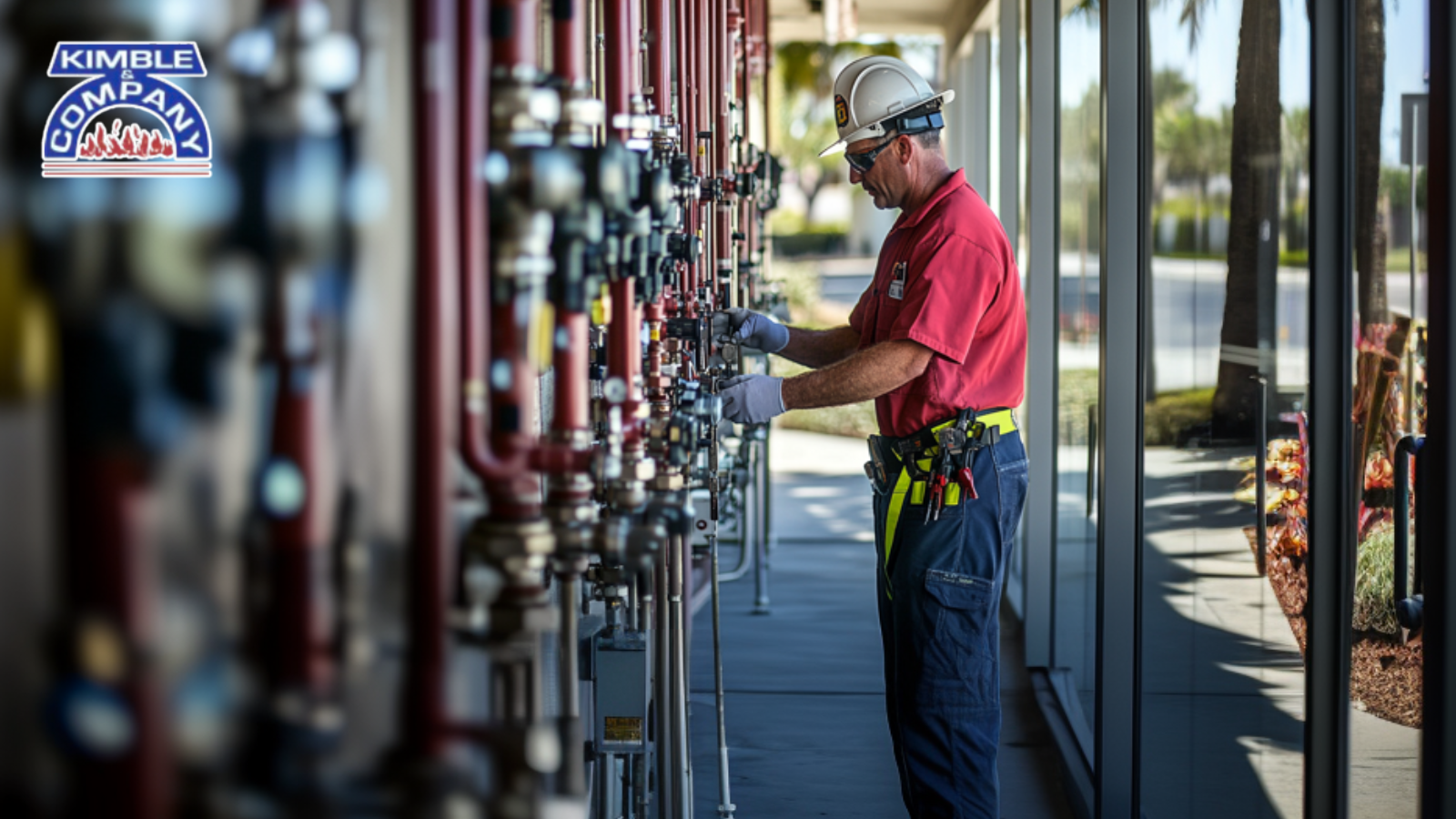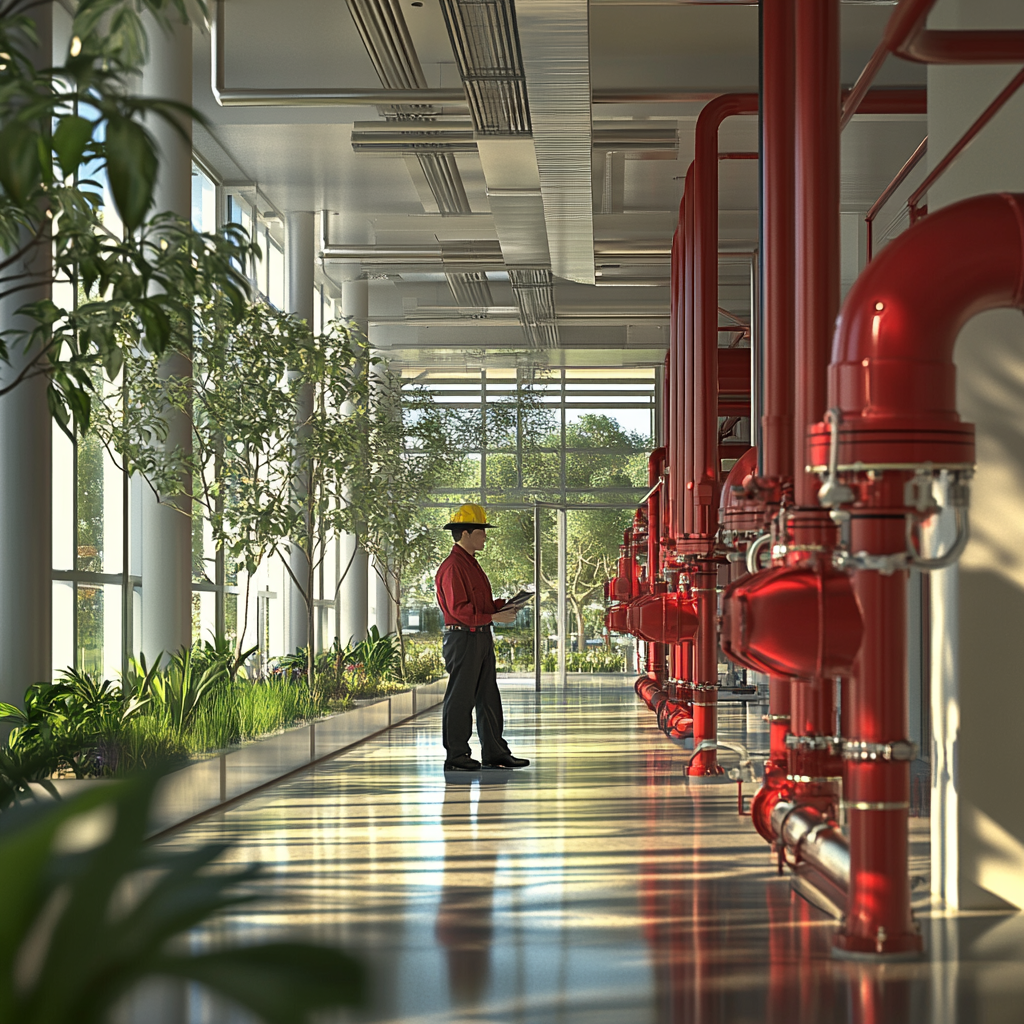Have you considered what differentiates a minor fire incident from a catastrophic event in California’s commercial arenas? Frequently, the answer is an effective fire sprinkler system, a critical component of comprehensive fire protection services.
In a state characterized by pioneering innovations and rigorous regulations, the decision to invest in these systems transcends mere upfront costs—it embodies a commitment to safety and adherence to legal standards. Yet, the question remains: what are the actual costs associated with installing and maintaining these fire protection services in California?
Overview of Commercial Fire Sprinkler Systems
Commercial fire sprinkler systems are engineered to activate automatically at the detection of elevated temperatures, indicative of a fire, ensuring swift action to control the spread of flames, minimize property damage, and protect lives. These systems consist of a meticulously designed network of water delivery devices positioned throughout a building, tailored to meet the unique architectural and fire safety requirements of each structure.
Effectiveness and Regulation of Fire Sprinkler Systems
The effectiveness of these systems in reducing damage and casualties during fires is profound, with buildings equipped with operational systems experiencing significantly lower losses compared to those without. This is supported by data from the National Fire Protection Association (NFPA), highlighting a reduction in losses by over 60% in sprinkler-equipped buildings. In California, strict regulations mandate the installation of these systems in many commercial and residential settings, enhancing safety and compliance with specific installation and maintenance standards.
Factors Influencing Installation Costs in California
Several distinct factors influence the cost of installing commercial fire sprinkler systems in California, each contributing to the final expense. Here’s a deeper look at what drives these costs:
Complexity of the System
Different buildings require different fire suppression solutions. For instance, a warehouse storing flammable materials needs a more sophisticated system than a typical office building. This complexity affects everything from design to the components used, escalating costs accordingly.
Building Regulations in California
California’s building codes are among the toughest in the nation, particularly regarding fire safety. These regulations mandate using high-quality materials and specific technologies that can withstand local environmental challenges, such as earthquakes. Adhering to these stringent standards often requires advanced engineering and design work, increasing the overall cost.
Material Choices
The type of materials selected for sprinkler systems significantly affects cost. California’s regulations may require non-standard materials that are more expensive but offer greater durability and adherence to environmental safety standards.
Labor Costs
The cost of skilled labor in California is higher than in many other states due to the high cost of living and specialized training required to install systems that comply with local codes. Skilled labor is essential for ensuring that fire sprinkler systems are installed correctly and function as intended.
Accessibility and Existing Infrastructure
Retrofitting buildings with new sprinkler systems can be particularly costly. Modifications may be necessary to integrate the system seamlessly with existing structures and utilities, which can be an extensive and expensive process, especially in older or historically significant buildings.
Understanding these elements helps in planning and budgeting effectively, ensuring both compliance with state regulations and optimal protection against fire risks.
Types of Fire Sprinkler Systems
Selecting the appropriate fire sprinkler system is vital for both effective fire suppression and cost management. The choice of system impacts not only the initial installation costs but also long-term maintenance and operational expenses. Here’s a detailed look at the primary types of sprinkler systems and how they align with different building requirements and environmental conditions.
Wet Pipe Systems
Cost Range: Generally the most cost-effective option
- Functionality: Wet pipe systems are the most common type of fire sprinkler system. They consist of pipes filled with water under pressure that discharge immediately when the sprinkler heads detect heat.
- Suitability: Ideal for most standard commercial environments, especially where temperatures remain above freezing, such as office buildings, schools, and residential complexes.
- Cost Factors: The installation is straightforward, resulting in lower upfront costs. Maintenance is also relatively simple, making it a budget-friendly option over the system’s lifecycle.
Dry Pipe Systems
Cost Range: More expensive than wet pipe systems due to added complexity
- Functionality: Dry pipe sprinkler systems are filled with air under pressure, and the water is held back by a control valve. The system releases water into the pipes when a fire is detected, which can take slightly longer than wet pipe systems.
- Suitability: Suitable for environments where temperatures may fall below freezing, such as unheated warehouses, parking garages, or in regions with cold climates.
- Cost Factors: Requires more components and more complex installation procedures. Maintenance costs are higher because the systems need frequent checks to ensure the air and water barriers remain functional.
Pre-action Systems
Cost Range: Typically, the most expensive option
- Functionality: Pre-action sprinkler systems are similar to dry pipe systems but with an added level of protection against accidental discharge. Water is released into the piping only after a fire has been detected by the fire alarm system, preventing water damage in case of false alarms.
- Suitability: Ideal for use in environments where accidental activation could be disastrous, such as data centers, libraries, and museums with valuable artifacts or electronics.
- Cost Factors: The dual-action detection system requires both heat detection and the alarm system’s activation to initiate water flow, necessitating a more intricate design and higher-quality components. These factors contribute to the higher installation and maintenance costs associated with pre-action systems.
Deluge Systems
Cost Range: Varies widely based on system complexity and installation environment
- Functionality: Deluge systems use open sprinkler heads with pipes that are not filled with water until activated. These systems are designed to deliver large quantities of water simultaneously to the entire system when a fire is detected.
- Suitability: Best suited for high-hazard areas where rapid fire spread is a risk, such as chemical plants or aircraft hangars.
- Cost Factors: Given their extensive coverage and the volume of water required, deluge systems can be expensive to install and maintain. The need for a large water supply and powerful pumps increases both the complexity and the cost.
Each type of fire sprinkler system offers distinct advantages depending on the specific needs of the property and its environment.
Material, Equipment, and Permit Costs
The selection and acquisition of materials, along with securing the necessary permits, form a significant part of the total expense associated with installing a fire sprinkler system. Here’s a closer look at how these costs can vary and the factors that influence them:
Materials
- Types of Materials: The primary materials used in fire sprinkler systems include piping, valves, and sprinkler heads. The choice of materials directly affects both cost and performance. For example, galvanized steel piping is more durable and resistant to corrosion but is more expensive than PVC piping, which is cheaper but less durable under certain conditions.
- Cost Influences: Material costs are subject to fluctuations in the global market, which can affect the prices of metal and plastic. Additionally, advancements in technology might lead to newer, more expensive materials that offer better fire protection or conformity with environmental standards.
Equipment
- Types of Equipment: Beyond basic piping and fixtures, specialized equipment such as fire detection sensors, alarms, and control panels are needed. The complexity and sensitivity of this equipment can significantly impact costs.
- Quality and Compliance: Higher-quality equipment generally comes with higher costs but can provide greater reliability and longer service life. Compliance with stringent California fire safety regulations may require equipment that meets specific performance criteria, adding to the expense.
Permit Costs
- Regulatory Requirements: In California, fire sprinkler systems must comply with local building codes and fire safety regulations, which are among the strictest in the nation. Obtaining permits is not merely a formality but a critical step in ensuring that fire sprinkler installation meets these rigorous standards.
- Inspection Fees: After installation, fire sprinkler systems must be inspected to confirm they are correctly installed and functional. These inspections typically involve fees that can vary depending on the municipality and the size of the system.
Additional Costs
- Design and Consultation Fees: Professional fees for system designers and consultants who ensure the fire sprinkler system is appropriately engineered for the specific building layout can also contribute to the overall costs.
- Maintenance Requirements: Regular maintenance is necessary to keep the system in optimal operating condition and compliant with ongoing safety regulations, which involves periodic checks and replacements of parts like valves and sprinkler heads.
Budgeting accurately for materials, equipment, and permits is essential for successful project execution and long-term system functionality, ensuring that the fire protection measures provide safety and comply with all legal requirements.
Ongoing Maintenance and Compliance Costs
Regular maintenance is crucial to ensuring that fire sprinkler systems remain operational and effective over time. This includes routine inspections, tests, and necessary updates mandated by state laws to prevent system failures and ensure readiness in case of a fire.
At Kimble & Company Fire Protection Systems, we deliver comprehensive maintenance services, meticulously designed to adhere to California’s stringent regulatory standards. Our offerings encompass regular system inspections, 24-hour emergency support, and professional repairs, ensuring that your fire protection systems consistently meet legal requirements and remain in peak operational condition.
Importance of Regular Maintenance:
- Routine Inspections: Regular checks are vital for identifying potential issues before they become major problems. This proactive approach helps maintain system integrity and prolongs the lifespan of the equipment.
- Alignment with State Laws: California enforces some of the strictest fire safety regulations, mandating periodic inspections and tests to verify that systems conform to safety standards. Ignoring these mandates can result in penalties and heightened liability risks.
- Cost of Maintenance: While there are costs associated with regular maintenance, these are significantly lower than the potential costs of system failure, including property damage and safety hazards. Maintenance can include replacing worn-out parts, updating software for alarm systems, and ensuring water pressure is adequate.
Regular maintenance not only upholds safety standards but also offers peace of mind, ensuring your property benefits from a reliable and effective fire safety system. With professional maintenance services from Kimble & Company, you can depend on your fire sprinkler systems to remain in optimal working condition, always ready to function when needed.
Investing in fire protection services in California is a vital step toward ensuring both safety and conformity with regulatory standards. Although the initial costs of a fire sprinkler system are significant, the benefits of protecting lives and property from potential fire hazards greatly surpass these expenses.
Through careful planning and a deep understanding of the factors influencing expenses, businesses can make well-informed decisions that balance safety requirements with financial considerations. For expert guidance and comprehensive fire protection services, reach out to Kimble & Company Fire Protection Systems today. Our team is prepared to offer the support and solutions necessary to optimize your fire safety strategies.


